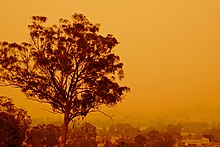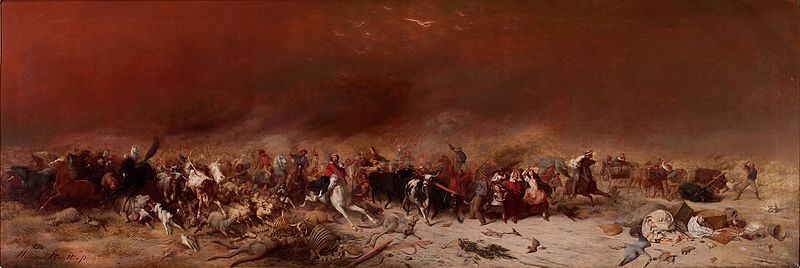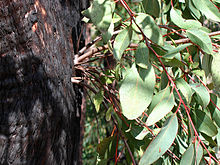Bushfires in Australia
Bushfires in Australia (Bushfire) occur mainly in the hot months of the year in the respective climatic zones of Australia. In Australian parlance, bushfires refer to fires that extend over large areas of bush, grass and rainforest in the country. These fires often kill many animals as well as people, and destroy buildings, cars, etc.
The climate in Australia is generally hot, dry and prone to drought. Bushfires in southern Australia tend to occur in the Australian summer and autumn. In New South Wales and southern Queensland, the greatest bushfire risk is in spring and early summer, and in the Northern Territory in winter and spring.
The bushfires are an environmental factor and intrinsic part of the ecology of the Australian continent. For example, the fires help some species of Eucalypts and Banksia to open their seed pods. As a disturbance to succession, fire also allows certain types of plants to regrow; further, many adapted plant species form new shoots soon after fires and quickly regrow, while species not part of the ecosystem are displaced by fire. For thousands of years, Aborigines have deliberately set bushfires for their hunting and to clear paths through impassable vegetation.
According to Geoscience Australia, from 1967 to 2013, 8000 people were injured and 433 killed in the course of significant Australian bushfires, accounting for about 50% of all deaths caused by natural events in the continent of Australia during the same period.
The Black Saturday bushfires in February 2009 killed 173 people and destroyed 1800 homes. The 60 or so individual bushfires in Victoria were one of Australia's largest fire disasters, burning an area the size of Saarland (2570 km²).
The ongoing 2019/2020 Australian bushfires killed 33 people immediately (and already by 25 January 2020). An area of 126,000 sq km fell victim to the flames as of 3 March 2020. These bushfires have been described as "unprecedented" in various publications. A state of emergency was declared in Sydney as well as in the surrounding state of New South Wales as well as in Victoria. Scientists attribute the unusually fierce fires, which occurred early in the fire season, to global warming. The fires were accompanied by prolonged drought and temperatures as high as 46°C (excluding heat from the fire). Research through May 2020 found that another estimated 445 died among the thousands treated in hospitals for illness from smoke.

Memorial to the 2003 bushfire in Canberra

View of the village of Swifts Creek during the 2006/2007 bushfires in Victoria in December 2006

Oil painting of a bush fire between Mount Elephant and Timboon by Eugene von Guerard (1857)
Definition
Australian bushfires are generally defined as uncontrolled fires of grass, scrub, brush and forest. There are two main categories based on terrain type:
- Bushfires in forested, hilly and mountainous areas:
These areas are sparsely developed, are not used for agriculture, and many of their forested areas are national, state, or other parks. Steep terrain increases the intensity and speed of fires, which pose a great danger to settlements and residents.
- Bushfires in flatlands or grasslands:
In flat or less hilly terrain, mostly covered by grasses and shrubs, brush fires can spread immensely fast, as they are often fanned by strong and hot winds and favoured by dry and easily ignited vegetation. Fires in grasslands can reach an intensity similar to hill country. Here, too, there is a great danger to human settlements. However, they are easier to forecast and contain regionally; moreover, these areas are easier for fire brigades to reach.
Natural triggers of bushfires are lightning strikes, sometimes these fires are caused by careless handling of cigarettes or by arson; occasionally fires start unintentionally during agricultural use of areas.
During the 2019/2020 bushfires, fires also occurred in subtropical Gondwana rainforests in Australia, some of which had not burned for more than 1000 years. Fires also occurred in wet eucalypt forests due to drought conditions that had lasted for several years, as well as in dried-up swamps and soils of organic material after the water table there had dropped.

enlarge and show information about the picture
![]()
Painting Black Thursday (Fire of 1851) by William Strutt (1825-1915)
History
Bushfires of natural origin have been present on the Australian continent for millions of years, triggered by lightning strikes and thus significantly shaped much of the landscape of the Australian continent before the arrival of man. Aboriginal people used fire for hunting and landscape management for many thousands of years, usually in the cooler seasons and when winds were favourable. Fires set in this way encouraged the growth and expansion of grasslands and facilitated hunting, as well as reducing the stock of combustible material and facilitating penetration into inhospitable areas with dense vegetation.
The increased occurrence of human-caused bushfires allowed fire-resistant plant species to spread, especially eucalypts. With their rapid formation of shoots after fires, woody stem bulges, and fire-resistant seeds, many plants adapted evolutionarily. Some species produce flammable oil, which increases fire effectiveness, eliminating non-fire resistant plant species in the surrounding area.
According to a summary published by the Australian CISRO in 2012, Australian fire and land management agencies dealt with 268,398 bush and grass fires between 2002 and 2007. That was an average of 53,680 fires per year. Assuming this trend had been constant throughout the 20th century, there would have been a total of about 5.5 million fires from 1901 to 2000.
Some of the most dangerous and large Australian bushfires since the arrival of European settlers have been (in chronological order):
| Fire | Area | Burnt area | Date | Dead | Destruction |
| Bushfire in Victoria 1851 | Victoria | estimated 50,000 km² | February 6, 1851 | approx. 12 | 1 million sheep, thousands of cattle |
| Red Tuesday Bushfires | Victoria | 2,600 km² | February 1, 1898 | 12 | 2,000 Buildings |
| Bushfire 1926 | Victoria | February-March 1926 | 60 | 1,000 houses | |
| Bushfire in Victoria 1939 | Victoria | 20,000 km² | December 1938 - January 1939, especially on 13 January 1939 | 71 | 3,700 houses |
| Bushfire 1944 | Victoria | approx. 10,000 km² | 14 January - 14 February 1944 | 15–20 | more than 500 houses |
| Bushfire 1951-1952 | Victoria | Summer 1951-1952 | 10 | ||
| Black Sunday Bushfire (1955) | South Australia | January 2, 1955 | 2 | ||
| Western Australia Bushfire 1961 | Western Australia | 18,000 km² | January-March 1961 | 0 | 160 houses |
| Bushfire 1962 | Victoria | 14-16 January 1962 | 32 | 450 houses | |
| Southern Highlands Bushfire | New South Wales | 5-14 March 1965 | 3 | 59 houses | |
| Tasmanian bushfire of 1967 | Tasmania | estimated 2,640 km² | 1967 | 62 | 1,293 houses |
| Dandenong Ranges Bushfire | Victoria | 19 km² | February 19, 1968 | 53 houses and 10 other buildings | |
| Bushfires in the Northern Territory 1968-1969 | Northern Territory | 400,000 km² | 1968–1969 | Killarney - Top Springs | |
| Bushfires in the Northern Territory 1969-1970 | Northern Territory | 450,000 km² | 1969–1970 | Dry River - Victoria River | |
| Bushfire in South Australia 1969 | Victoria | January 8, 1969 | 23 | 230 houses | |
| Northern Territory Bushfires 1974-1975 | Northern Territory | 450,000 km² | 1974–1975 | Barkly Tableland, Victoria River District, near Newcastle Waters | |
| 1974-1975 Western Australia Bushfire | Western Australia | 290,000 km² | 1974–1975 | ||
| 1974-1975 South Australia Bushfire | South Australia | 170,000 km² | 1974–1975 | ||
| Western Districts-Bushfire | Victoria | 1,030 km² | February 12, 1977 | 4 | 116 houses and 340 buildings |
| Western Australia Bushfire 1978 | Western Australia | 1,140 km² | April 4, 1978 | 2 | 6 buildings (the falling wind in the early evening is believed to have saved the towns of Donnybrook, Boyup Brook, Manjimup and Bridgetown) |
| Northern Sydney Bushfire | New South Wales | 1979 | 20 homes in Sydney, the fire spread to Ku-ring-gai-Chase National Park. | ||
| Ash-Wednesday-Bushfires | South Australia and Victoria | 4,180 km² | February 16, 1983 | 75 | about 2,400 houses |
| Central Victoria Bushfire | Victoria | 508 km² | January 14, 1985 | 3 | > 180 houses |
| Eastern Seaboard Bushfires 1994 | New South Wales | 27 December 1993 - 16 January 1994 | 4 | 225 houses | |
| Wooroloo Bushfire | Western Australia | 105 km² | 8 January 1997 | 0 | 16 houses |
| Dandenongs Bushfire | Victoria | 4 km² | 21 January 1997 | 3 | 41 houses |
| Lithgow Bushfire | New South Wales | 2 December 1997 | 2 | ||
| Perth-and-SW-Region-Bushfire | Western Australia | 230 km² | 2 December 1997 | 2 (21 injured) | 1 House |
| Linton Bush Fire | Victoria | 1998 | 5 | There were 5 firefighters who died in the line of duty on December 2, 1998. | |
| Black Christmas Bushfire | New South Wales | 3,000 km² | 2001–2002 | 0 | 121 houses |
| 2002 Northern Territory Bushfire | Northern Territory | 380,000 km² | 2002 | ||
| Bushfire in Canberra 2003 | Australian Capital Territory | 2003 | 4 | nearly 500 houses, Canberra | |
| Bushfire in Victoria 2003 | Victoria | > 13,000 km² | 8 January - 7 March 2003 | 41 houses. The bushfire burned for 59 days. | |
| Tenterden | Western Australia | December 2003 | 2 | (21,100 km² of forest burned during the 2002-2003 bushfire season in southwestern Western Australia) | |
| Eyre Peninsula Bushfire | South Australia | 8,900 km² | 10-12 January 2005 | 9 | about 50 houses |
| Central Coast Bushfire 2006 | New South Wales - Central Coast | New Year's Day 2006 | |||
| Jail Break Inn Fire | New South Wales - Junee Shire | 300 km² | New Year's Day 2006 | 0 | 20,000 head of cattle. 7 houses, 7 combines and 4 sheep pens destroyed. 1,500 km of fence was damaged. |
| Victoria bushfire 2005 | Victoria | 1,600 km² | December 2005 - January 2006 | 4 | 57 houses, 359 farm buildings, 65,000 head of livestock. The bushfires occurred in the Stawell, Moondarra, Anakie, Yea and Kingla regions. |
| Grampians Bushfire | Victoria | 1,840 km² | January 2006 | 2 | 25 houses destroyed, 62,000 sheep and 500 cattle burned. |
| Pulletop Bushfire | New South Wales - Wagga Wagga | 90 km² | February 6, 2006 | 0 | 2,500 sheep, 6 head of cattle, 3 vehicles, 2 straw barns and 50 km of fence was destroyed |
| The Great Divides Fire | Victoria | 10,480 km² | 1 December 2006 - March 2007 | 1 | 51 houses |
| Bushfires in Victoria 2006/2007 | Victoria | approx. 12,000 km² | 1 December 2006 - 7 February 2007 | 1 | 41 houses destroyed. The bushfire burned for 69 days |
| Dwellingup Bush Fire | Western Australia | 120 km² | February 4, 2007 | 0 | 12 houses destroyed. |
| Kangaroo Island Bushfire | South Australia | 950 km² | 6-14 December 2007 | 1 | Flinders Chase National Park (630 km² or 85 % of the area of the national park burnt) |
| Boorabbin National Park Bushfire | Western Australia | 400 km² | 30 December 2007 | 3 | Overhead power lines and Great Eastern Highway were destroyed and not usable for 2 weeks |
| Black Saturday Bushfires | Victoria | > 4,500 km² | 7 February 2009 - 14 March 2009 | 173 | > 2,029 houses and 2,000 other structures. In the course of this bushfire, three lightning-generating fire clouds, so-called pyrocumulonimbus, were formed, which rose to a height of up to 15 kilometres. |
| Toodyay Bush Fire | Western Australia | > 30 km² | December 29, 2009 | 0 | 37 houses |
| Lake Clifton brush fire | Western Australia | > 20 km² | 11 January 2011 | 0 | 10 houses destroyed |
| Roleystone-Kelmscott Bush Fire | Western Australia | > 15 km² | 6-8 February 2011 | 0 | 72 homes destroyed, 32 damaged, the Buckingham Bridge on Brookton Highway collapsed and had to be replaced with a temporary bridge. |
| Bushfires in Australia 2019/2020 | New South Wales, Queensland, South Australia, Victoria, Western Australia, Tasmania, Northern Territory | > 126,000 km² | August 2019 - March 2020 | 33 directly + estimated 445 from smoking | 5,900 buildings including 2,800 homes destroyed; 80% of Australia's residents hit by smoke, thousands treated in hospitals for smoke-related illnesses at a cost of AUSD 2 billion (1.2 billion euros), an estimated additional 445 deaths from smoke-related illnesses |
| Bushfire Fraser Island | Queensland | > 800 km² | From mid-October 2020 |

Two years after the Bogong bushfire, the forest in Victoria's eastern Gippsland shows the recovery of trees and vegetation.

Shoots from the bark of a eucalyptus tree after a large bushfire, a survival strategy of plants after fire damage.
Search within the encyclopedia